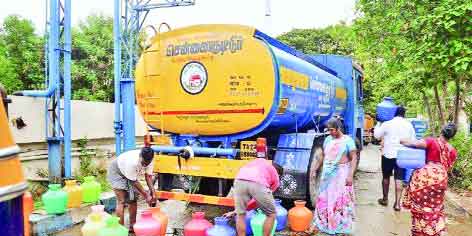The unprecedented scarcity in Chennai is a result of poor urban planning and the lack of political will in finding radical solutions. Unless we devise sustainable solutions, this precarious crisis can well hold all our metropolises to ransom
Chennai is an apt example of all that is wrong with environment in India. The year 2015 saw the city reel under the worst floods experienced by the region. This year, the city is a witness to the worst ever drought in the recent times, prompting the Central Government to take notice and put in emergency measures to tackle the problem. The crisis is quite severe as the city is left with just two per cent of water in local reservoirs. Some rains would have gone a long way towards lifting its collective spirit but they are still elusive.
The rapid fluctuation of water resources for this city is evident as the city has oscillated between plenty to scarcity within a gap of four years. What is the reason behind these ominous problems? One of the issues is the upstream of Chennai — there is over-exploitation of lake and groundwater resources here as farmers use the unsustainable flood irrigation technique for watering their fields. This in turn adversely impacts ground water tables. This can be avoided with the Tamil Nadu government helping to fund more advanced drip irrigation systems for farmers. This, if implemented on a large scale, can rejuvenate the lakes around the city and the groundwater table as well.
Furthermore, it is high time that the city invests in robust, efficient and sustainable rainwater harvesting systems that not only complement the water table and water bodies but also lend a helping hand in times of scarcity. It is also crucial to find ways to imaginatively re-use wastewater in order to handle and regulate demand pressures. But it is quite clear that the city infrastructure is faced with population overload and this can be mitigated by creating economic opportunities outside of Chennai so that the pressure on the city is reduced. These measures can prevent Chennai and other Indian cities from continuing their inexorable march towards ‘day zero’ scenarios for natural resources when the price to be paid will be more than we can afford.
The water shortage has also been compounded due to less rainfall, which has been half its normal quota. The northeast or ‘retreating’ monsoon, which occurs in November and December, usually accounts for more than 60 per cent of Chennai’s annual rainfall on which the city now pins its earnest hopes. But right now the situation is quite grim as the city has received zero rainfall since March and the recent rise in temperatures has left the city high and dry. Add to this consecutive drought years, which have dried the city lakes and led to drastic drops in water tables.
The four major city reservoirs, with a total capacity of 11.5 thousand million cubic feet (TMC ft), have only 0.3 TMC ft of water in them. To put things in perspective, even in 2017, when Tamil Nadu experienced the worst drought in 140 years due to the failure of the monsoon, the city reservoirs had 0.7 TMC ft during the beginning of May. Cyclone Fani, which formed over the Bay of Bengal at the end of April, gave some hope to the city. However, the storm changed its course and curved towards Odisha, leaving Chennai high and dry again.
Chennai requires around 850 million litres of water everyday and studies suggest that groundwater extraction here has been highly unsustainable. In the last decade, groundwater levels across the city have dropped by 85 per cent. Moreover, continued uncertainties in monsoon rainfall owing to global warming and other environmental triggers have compounded people’s woes. The lakes and reservoirs are drying up more frequently, making the traditional ways of water supply unviable for the future.
In order to arrest the crisis, the Central Government, in tandem with the State Government, must first focus on alleviating water shortage. Then it must strictly monitor the construction industry to ensure that all new projects are in compliance with water harvesting systems. This must be combined with lake and reservoir conservation mechanisms that help in maintaining critical levels of water throughout the year. The Central Government must also ensure that the citizens have an alternate option to log their protests regarding their woes.
Chennai’s state of affairs must not be seen as one-off. This plight can affect any city of India which has not been careful with its resources. The Government plays a pivotal role in ensuring that this chaos does not prevail across the country. The National Green Tribunal must take cognisance of environmental factors that contribute to such circumstances. It must ensure strict action against errant parties who stress and tax the environment and even impose punitive measures. Unless strict measures are taken, results cannot be expected.
(The writer is an environmental journalist)


























